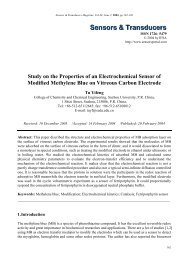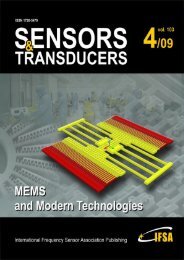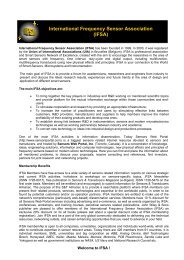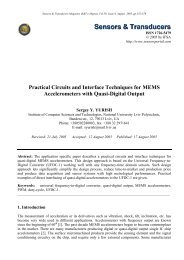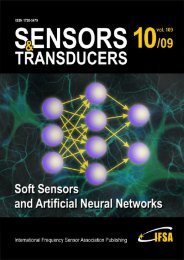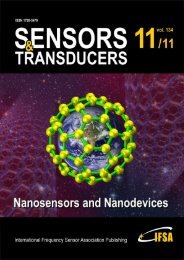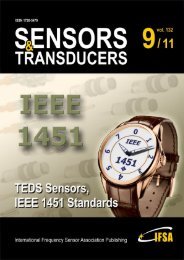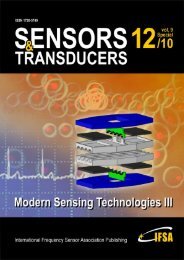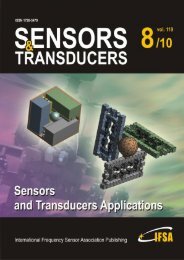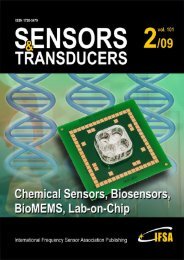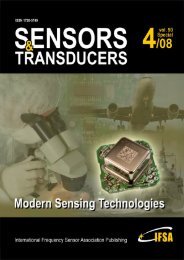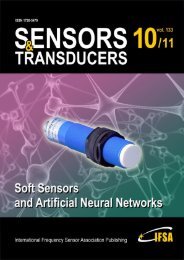Design of MEMS Cantilever - Hand Calculation - International ...
Design of MEMS Cantilever - Hand Calculation - International ...
Design of MEMS Cantilever - Hand Calculation - International ...
You also want an ePaper? Increase the reach of your titles
YUMPU automatically turns print PDFs into web optimized ePapers that Google loves.
Sensors & Transducers<br />
Volume 91<br />
Issue 4<br />
April 2008<br />
www.sensorsportal.com ISSN 1726-5479<br />
Editor-in-Chief: pr<strong>of</strong>essor Sergey Y. Yurish, phone: +34 696067716, fax: +34 93 4011989,<br />
e-mail: editor@sensorsportal.com<br />
Editors for Western Europe<br />
Meijer, Gerard C.M., Delft University <strong>of</strong> Technology, The Netherlands<br />
Ferrari, Vitorio, Universitá di Brescia, Italy<br />
Editors for North America<br />
Datskos, Panos G., Oak Ridge National Laboratory, USA<br />
Fabien, J. Josse, Marquette University, USA<br />
Katz, Evgeny, Clarkson University, USA<br />
Abdul Rahim, Ruzairi, Universiti Teknologi, Malaysia<br />
Ahmad, Mohd Noor, Nothern University <strong>of</strong> Engineering, Malaysia<br />
Annamalai, Karthigeyan, National Institute <strong>of</strong> Advanced Industrial<br />
Science and Technology, Japan<br />
Arcega, Francisco, University <strong>of</strong> Zaragoza, Spain<br />
Arguel, Philippe, CNRS, France<br />
Ahn, Jae-Pyoung, Korea Institute <strong>of</strong> Science and Technology, Korea<br />
Arndt, Michael, Robert Bosch GmbH, Germany<br />
Ascoli, Giorgio, George Mason University, USA<br />
Atalay, Selcuk, Inonu University, Turkey<br />
Atghiaee, Ahmad, University <strong>of</strong> Tehran, Iran<br />
Augutis, Vygantas, Kaunas University <strong>of</strong> Technology, Lithuania<br />
Avachit, Patil Lalchand, North Maharashtra University, India<br />
Ayesh, Aladdin, De Montfort University, UK<br />
Bahreyni, Behraad, University <strong>of</strong> Manitoba, Canada<br />
Baoxian, Ye, Zhengzhou University, China<br />
Barford, Lee, Agilent Laboratories, USA<br />
Barlingay, Ravindra, RF Arrays Systems, India<br />
Basu, Sukumar, Jadavpur University, India<br />
Beck, Stephen, University <strong>of</strong> Sheffield, UK<br />
Ben Bouzid, Sihem, Institut National de Recherche Scientifique, Tunisia<br />
Binnie, T. David, Napier University, UK<br />
Bisch<strong>of</strong>f, Gerlinde, Inst. Analytical Chemistry, Germany<br />
Bodas, Dhananjay, IMTEK, Germany<br />
Borges Carval, Nuno, Universidade de Aveiro, Portugal<br />
Bousbia-Salah, Mounir, University <strong>of</strong> Annaba, Algeria<br />
Bouvet, Marcel, CNRS – UPMC, France<br />
Brudzewski, Kazimierz, Warsaw University <strong>of</strong> Technology, Poland<br />
Cai, Chenxin, Nanjing Normal University, China<br />
Cai, Qingyun, Hunan University, China<br />
Campanella, Luigi, University La Sapienza, Italy<br />
Carvalho, Vitor, Minho University, Portugal<br />
Cecelja, Franjo, Brunel University, London, UK<br />
Cerda Belmonte, Judith, Imperial College London, UK<br />
Chakrabarty, Chandan Kumar, Universiti Tenaga Nasional, Malaysia<br />
Chakravorty, Dipankar, Association for the Cultivation <strong>of</strong> Science, India<br />
Changhai, Ru, Harbin Engineering University, China<br />
Chaudhari, Gajanan, Shri Shivaji Science College, India<br />
Chen, Jiming, Zhejiang University, China<br />
Chen, Rongshun, National Tsing Hua University, Taiwan<br />
Cheng, Kuo-Sheng, National Cheng Kung University, Taiwan<br />
Chiriac, Horia, National Institute <strong>of</strong> Research and Development, Romania<br />
Chowdhuri, Arijit, University <strong>of</strong> Delhi, India<br />
Chung, Wen-Yaw, Chung Yuan Christian University, Taiwan<br />
Corres, Jesus, Universidad Publica de Navarra, Spain<br />
Cortes, Camilo A., Universidad Nacional de Colombia, Colombia<br />
Courtois, Christian, Universite de Valenciennes, France<br />
Cusano, Andrea, University <strong>of</strong> Sannio, Italy<br />
D'Amico, Arnaldo, Università di Tor Vergata, Italy<br />
De Stefano, Luca, Institute for Microelectronics and Microsystem, Italy<br />
Deshmukh, Kiran, Shri Shivaji Mahavidyalaya, Barshi, India<br />
Dickert, Franz L., Vienna University, Austria<br />
Dieguez, Angel, University <strong>of</strong> Barcelona, Spain<br />
Dimitropoulos, Panos, University <strong>of</strong> Thessaly, Greece<br />
Ding Jian, Ning, Jiangsu University, China<br />
Djordjevich, Alexandar, City University <strong>of</strong> Hong Kong, Hong Kong<br />
Editorial Advisory Board<br />
Editor South America<br />
Costa-Felix, Rodrigo, Inmetro, Brazil<br />
Editor for Eastern Europe<br />
Sachenko, Anatoly, Ternopil State Economic University, Ukraine<br />
Editor for Asia<br />
Ohyama, Shinji, Tokyo Institute <strong>of</strong> Technology, Japan<br />
Donato, Nicola, University <strong>of</strong> Messina, Italy<br />
Donato, Patricio, Universidad de Mar del Plata, Argentina<br />
Dong, Feng, Tianjin University, China<br />
Drljaca, Predrag, Instersema Sensoric SA, Switzerland<br />
Dubey, Venketesh, Bournemouth University, UK<br />
Enderle, Stefan, University <strong>of</strong> Ulm and KTB Mechatronics GmbH,<br />
Germany<br />
Erdem, Gursan K. Arzum, Ege University, Turkey<br />
Erkmen, Aydan M., Middle East Technical University, Turkey<br />
Estelle, Patrice, Insa Rennes, France<br />
Estrada, Horacio, University <strong>of</strong> North Carolina, USA<br />
Faiz, Adil, INSA Lyon, France<br />
Fericean, Sorin, Balluff GmbH, Germany<br />
Fernandes, Joana M., University <strong>of</strong> Porto, Portugal<br />
Francioso, Luca, CNR-IMM Institute for Microelectronics and<br />
Microsystems, Italy<br />
Francis, Laurent, University Catholique de Louvain, Belgium<br />
Fu, Weiling, South-Western Hospital, Chongqing, China<br />
Gaura, Elena, Coventry University, UK<br />
Geng, Yanfeng, China University <strong>of</strong> Petroleum, China<br />
Gole, James, Georgia Institute <strong>of</strong> Technology, USA<br />
Gong, Hao, National University <strong>of</strong> Singapore, Singapore<br />
Gonzalez de la Rosa, Juan Jose, University <strong>of</strong> Cadiz, Spain<br />
Granel, Annette, Goteborg University, Sweden<br />
Graff, Mason, The University <strong>of</strong> Texas at Arlington, USA<br />
Guan, Shan, Eastman Kodak, USA<br />
Guillet, Bruno, University <strong>of</strong> Caen, France<br />
Guo, Zhen, New Jersey Institute <strong>of</strong> Technology, USA<br />
Gupta, Narendra Kumar, Napier University, UK<br />
Hadjiloucas, Sillas, The University <strong>of</strong> Reading, UK<br />
Hashsham, Syed, Michigan State University, USA<br />
Hernandez, Alvaro, University <strong>of</strong> Alcala, Spain<br />
Hernandez, Wilmar, Universidad Politecnica de Madrid, Spain<br />
Homentcovschi, Dorel, SUNY Binghamton, USA<br />
Horstman, Tom, U.S. Automation Group, LLC, USA<br />
Hsiai, Tzung (John), University <strong>of</strong> Southern California, USA<br />
Huang, Jeng-Sheng, Chung Yuan Christian University, Taiwan<br />
Huang, Star, National Tsing Hua University, Taiwan<br />
Huang, Wei, PSG <strong>Design</strong> Center, USA<br />
Hui, David, University <strong>of</strong> New Orleans, USA<br />
Jaffrezic-Renault, Nicole, Ecole Centrale de Lyon, France<br />
Jaime Calvo-Galleg, Jaime, Universidad de Salamanca, Spain<br />
James, Daniel, Griffith University, Australia<br />
Janting, Jakob, DELTA Danish Electronics, Denmark<br />
Jiang, Liudi, University <strong>of</strong> Southampton, UK<br />
Jiao, Zheng, Shanghai University, China<br />
John, Joachim, IMEC, Belgium<br />
Kalach, Andrew, Voronezh Institute <strong>of</strong> Ministry <strong>of</strong> Interior, Russia<br />
Kang, Moonho, Sunmoon University, Korea South<br />
Kaniusas, Eugenijus, Vienna University <strong>of</strong> Technology, Austria<br />
Katake, Anup, Texas A&M University, USA<br />
Kausel, Wilfried, University <strong>of</strong> Music, Vienna, Austria<br />
Kavasoglu, Nese, Mugla University, Turkey<br />
Ke, Cathy, Tyndall National Institute, Ireland<br />
Khan, Asif, Aligarh Muslim University, Aligarh, India<br />
Kim, Min Young, Koh Young Technology, Inc., Korea South
Ko, Sang Choon, Electronics and Telecommunications Research Institute,<br />
Korea South<br />
Kockar, Hakan, Balikesir University, Turkey<br />
Kotulska, Malgorzata, Wroclaw University <strong>of</strong> Technology, Poland<br />
Kratz, Henrik, Uppsala University, Sweden<br />
Kumar, Arun, University <strong>of</strong> South Florida, USA<br />
Kumar, Subodh, National Physical Laboratory, India<br />
Kung, Chih-Hsien, Chang-Jung Christian University, Taiwan<br />
Lacnjevac, Caslav, University <strong>of</strong> Belgrade, Serbia<br />
Lay-Ekuakille, Aime, University <strong>of</strong> Lecce, Italy<br />
Lee, Jang Myung, Pusan National University, Korea South<br />
Lee, Jun Su, Amkor Technology, Inc. South Korea<br />
Lei, Hua, National Starch and Chemical Company, USA<br />
Li, Genxi, Nanjing University, China<br />
Li, Hui, Shanghai Jiaotong University, China<br />
Li, Xian-Fang, Central South University, China<br />
Liang, Yuanchang, University <strong>of</strong> Washington, USA<br />
Liawruangrath, Saisunee, Chiang Mai University, Thailand<br />
Liew, Kim Meow, City University <strong>of</strong> Hong Kong, Hong Kong<br />
Lin, Hermann, National Kaohsiung University, Taiwan<br />
Lin, Paul, Cleveland State University, USA<br />
Linderholm, Pontus, EPFL - Microsystems Laboratory, Switzerland<br />
Liu, Aihua, University <strong>of</strong> Oklahoma, USA<br />
Liu Changgeng, Louisiana State University, USA<br />
Liu, Cheng-Hsien, National Tsing Hua University, Taiwan<br />
Liu, Songqin, Southeast University, China<br />
Lodeiro, Carlos, Universidade NOVA de Lisboa, Portugal<br />
Lorenzo, Maria Encarnacio, Universidad Autonoma de Madrid, Spain<br />
Lukaszewicz, Jerzy Pawel, Nicholas Copernicus University, Poland<br />
Ma, Zhanfang, Northeast Normal University, China<br />
Majstorovic, Vidosav, University <strong>of</strong> Belgrade, Serbia<br />
Marquez, Alfredo, Centro de Investigacion en Materiales Avanzados,<br />
Mexico<br />
Matay, Ladislav, Slovak Academy <strong>of</strong> Sciences, Slovakia<br />
Mathur, Prafull, National Physical Laboratory, India<br />
Maurya, D.K., Institute <strong>of</strong> Materials Research and Engineering, Singapore<br />
Mekid, Samir, University <strong>of</strong> Manchester, UK<br />
Melnyk, Ivan, Photon Control Inc., Canada<br />
Mendes, Paulo, University <strong>of</strong> Minho, Portugal<br />
Mennell, Julie, Northumbria University, UK<br />
Mi, Bin, Boston Scientific Corporation, USA<br />
Minas, Graca, University <strong>of</strong> Minho, Portugal<br />
Moghavvemi, Mahmoud, University <strong>of</strong> Malaya, Malaysia<br />
Mohammadi, Mohammad-Reza, University <strong>of</strong> Cambridge, UK<br />
Molina Flores, Esteban, Benemérita Universidad Autónoma de Puebla,<br />
Mexico<br />
Moradi, Majid, University <strong>of</strong> Kerman, Iran<br />
Morello, Rosario, DIMET, University "Mediterranea" <strong>of</strong> Reggio Calabria,<br />
Italy<br />
Mounir, Ben Ali, University <strong>of</strong> Sousse, Tunisia<br />
Mukhopadhyay, Subhas, Massey University, New Zealand<br />
Neelamegam, Periasamy, Sastra Deemed University, India<br />
Neshkova, Milka, Bulgarian Academy <strong>of</strong> Sciences, Bulgaria<br />
Oberhammer, Joachim, Royal Institute <strong>of</strong> Technology, Sweden<br />
Ould Lahoucin, University <strong>of</strong> Guelma, Algeria<br />
Pamidighanta, Sayanu, Bharat Electronics Limited (BEL), India<br />
Pan, Jisheng, Institute <strong>of</strong> Materials Research & Engineering, Singapore<br />
Park, Joon-Shik, Korea Electronics Technology Institute, Korea South<br />
Penza, Michele, ENEA C.R., Italy<br />
Pereira, Jose Miguel, Instituto Politecnico de Setebal, Portugal<br />
Petsev, Dimiter, University <strong>of</strong> New Mexico, USA<br />
Pogacnik, Lea, University <strong>of</strong> Ljubljana, Slovenia<br />
Post, Michael, National Research Council, Canada<br />
Prance, Robert, University <strong>of</strong> Sussex, UK<br />
Prasad, Ambika, Gulbarga University, India<br />
Prateepasen, Asa, Kingmoungut's University <strong>of</strong> Technology, Thailand<br />
Pullini, Daniele, Centro Ricerche FIAT, Italy<br />
Pumera, Martin, National Institute for Materials Science, Japan<br />
Radhakrishnan, S. National Chemical Laboratory, Pune, India<br />
Rajanna, K., Indian Institute <strong>of</strong> Science, India<br />
Ramadan, Qasem, Institute <strong>of</strong> Microelectronics, Singapore<br />
Rao, Basuthkar, Tata Inst. <strong>of</strong> Fundamental Research, India<br />
Rao<strong>of</strong>, Kosai, Joseph Fourier University <strong>of</strong> Grenoble, France<br />
Reig, Candid, University <strong>of</strong> Valencia, Spain<br />
Restivo, Maria Teresa, University <strong>of</strong> Porto, Portugal<br />
Robert, Michel, University Henri Poincare, France<br />
Rezazadeh, Ghader, Urmia University, Iran<br />
Royo, Santiago, Universitat Politecnica de Catalunya, Spain<br />
Rodriguez, Angel, Universidad Politecnica de Cataluna, Spain<br />
Rothberg, Steve, Loughborough University, UK<br />
Sadana, Ajit, University <strong>of</strong> Mississippi, USA<br />
Sadeghian Marnani, Hamed, TU Delft, The Netherlands<br />
Sandacci, Serghei, Sensor Technology Ltd., UK<br />
Sapozhnikova, Ksenia, D.I.Mendeleyev Institute for Metrology, Russia<br />
Saxena, Vibha, Bhbha Atomic Research Centre, Mumbai, India<br />
Schneider, John K., Ultra-Scan Corporation, USA<br />
Seif, Selemani, Alabama A & M University, USA<br />
Seifter, Achim, Los Alamos National Laboratory, USA<br />
Sengupta, Deepak, Advance Bio-Photonics, India<br />
Shearwood, Christopher, Nanyang Technological University, Singapore<br />
Shin, Kyuho, Samsung Advanced Institute <strong>of</strong> Technology, Korea<br />
Shmaliy, Yuriy, Kharkiv National University <strong>of</strong> Radio Electronics,<br />
Ukraine<br />
Silva Girao, Pedro, Technical University <strong>of</strong> Lisbon, Portugal<br />
Singh, V. R., National Physical Laboratory, India<br />
Slomovitz, Daniel, UTE, Uruguay<br />
Smith, Martin, Open University, UK<br />
Soleymanpour, Ahmad, Damghan Basic Science University, Iran<br />
Somani, Prakash R., Centre for Materials for Electronics Technol., India<br />
Srinivas, Talabattula, Indian Institute <strong>of</strong> Science, Bangalore, India<br />
Srivastava, Arvind K., Northwestern University, USA<br />
Stefan-van Staden, Raluca-Ioana, University <strong>of</strong> Pretoria, South Africa<br />
Sumriddetchka, Sarun, National Electronics and Computer Technology<br />
Center, Thailand<br />
Sun, Chengliang, Polytechnic University, Hong-Kong<br />
Sun, Dongming, Jilin University, China<br />
Sun, Junhua, Beijing University <strong>of</strong> Aeronautics and Astronautics, China<br />
Sun, Zhiqiang, Central South University, China<br />
Suri, C. Raman, Institute <strong>of</strong> Microbial Technology, India<br />
Sysoev, Victor, Saratov State Technical University, Russia<br />
Szewczyk, Roman, Industrial Research Institute for Automation and<br />
Measurement, Poland<br />
Tan, Ooi Kiang, Nanyang Technological University, Singapore,<br />
Tang, Dianping, Southwest University, China<br />
Tang, Jaw-Luen, National Chung Cheng University, Taiwan<br />
Teker, Kasif, Frostburg State University, USA<br />
Thumbavanam Pad, Kartik, Carnegie Mellon University, USA<br />
Tian, Gui Yun, University <strong>of</strong> Newcastle, UK<br />
Tsiantos, Vassilios, Technological Educational Institute <strong>of</strong> Kaval, Greece<br />
Tsigara, Anna, National Hellenic Research Foundation, Greece<br />
Twomey, Karen, University College Cork, Ireland<br />
Valente, Antonio, University, Vila Real, - U.T.A.D., Portugal<br />
Vaseashta, Ashok, Marshall University, USA<br />
Vazques, Carmen, Carlos III University in Madrid, Spain<br />
Vieira, Manuela, Instituto Superior de Engenharia de Lisboa, Portugal<br />
Vigna, Benedetto, STMicroelectronics, Italy<br />
Vrba, Radimir, Brno University <strong>of</strong> Technology, Czech Republic<br />
Wandelt, Barbara, Technical University <strong>of</strong> Lodz, Poland<br />
Wang, Jiangping, Xi'an Shiyou University, China<br />
Wang, Kedong, Beihang University, China<br />
Wang, Liang, Advanced Micro Devices, USA<br />
Wang, Mi, University <strong>of</strong> Leeds, UK<br />
Wang, Shinn-Fwu, Ching Yun University, Taiwan<br />
Wang, Wei-Chih, University <strong>of</strong> Washington, USA<br />
Wang, Wensheng, University <strong>of</strong> Pennsylvania, USA<br />
Watson, Steven, Center for NanoSpace Technologies Inc., USA<br />
Weiping, Yan, Dalian University <strong>of</strong> Technology, China<br />
Wells, Stephen, Southern Company Services, USA<br />
Wolkenberg, Andrzej, Institute <strong>of</strong> Electron Technology, Poland<br />
Woods, R. Clive, Louisiana State University, USA<br />
Wu, DerHo, National Pingtung University <strong>of</strong> Science and Technology,<br />
Taiwan<br />
Wu, Zhaoyang, Hunan University, China<br />
Xiu Tao, Ge, Chuzhou University, China<br />
Xu, Lisheng, The Chinese University <strong>of</strong> Hong Kong, Hong Kong<br />
Xu, Tao, University <strong>of</strong> California, Irvine, USA<br />
Yang, Dongfang, National Research Council, Canada<br />
Yang, Wuqiang, The University <strong>of</strong> Manchester, UK<br />
Ymeti, Aurel, University <strong>of</strong> Twente, Netherland<br />
Yu, Haihu, Wuhan University <strong>of</strong> Technology, China<br />
Yufera Garcia, Alberto, Seville University, Spain<br />
Zagnoni, Michele, University <strong>of</strong> Southampton, UK<br />
Zeni, Luigi, Second University <strong>of</strong> Naples, Italy<br />
Zhong, Haoxiang, Henan Normal University, China<br />
Zhang, Minglong, Shanghai University, China<br />
Zhang, Qintao, University <strong>of</strong> California at Berkeley, USA<br />
Zhang, Weiping, Shanghai Jiao Tong University, China<br />
Zhang, Wenming, Shanghai Jiao Tong University, China<br />
Zhou, Zhi-Gang, Tsinghua University, China<br />
Zorzano, Luis, Universidad de La Rioja, Spain<br />
Zourob, Mohammed, University <strong>of</strong> Cambridge, UK<br />
Sensors & Transducers Journal (ISSN 1726-5479) is a peer review international journal published monthly online by <strong>International</strong> Frequency Sensor Association (IFSA).<br />
Available in electronic and CD-ROM. Copyright © 2007 by <strong>International</strong> Frequency Sensor Association. All rights reserved.
Sensors & Transducers Journal<br />
Contents<br />
Volume 91<br />
Issue 4<br />
April 2008<br />
www.sensorsportal.com ISSN 1726-5479<br />
Research Articles<br />
Active Sensing in Ambient Conditions Using an Electrostatically Driven Silicon<br />
Microcantilever<br />
G. Keskar, B. Elliott, M. J. Skove, J. Gaillard, S. M. Serkiz and A. M. Rao ........................................ 1<br />
<strong>MEMS</strong> Tunneling Wide Range Micro Thermometer Based on Bimetallic <strong>Cantilever</strong> Beam<br />
Samrand K. Nezhadian, Shahram Khalilariya, Ghader Rezazadeh................................................... 14<br />
<strong>Cantilever</strong> Embedded MOSFET Characteristics for Detection <strong>of</strong> Photosystem I Reaction<br />
Centers<br />
Sazia A. Eliza, Ida Lee, Syed K. Islam and Elias Greenbaum ........................................................... 24<br />
<strong>Design</strong> and Analysis <strong>of</strong> Wet Etching Based Comb Type Capacitive Accelerometer<br />
Shankar Dutta, Shaveta, R. Pal, D. K. Bhattacharya, P. Datta and R. Chatterjee ............................ 31<br />
Flexible Membrane LRC Strain Sensor Fabricated Using <strong>MEMS</strong> Method<br />
Hee C. Lim, James Zunino III and John F. Federici........................................................................... 39<br />
Influence <strong>of</strong> Pd Layer on the Sensitivity <strong>of</strong> CHx/PS/Si as Structure for Oxygen Sensing<br />
N. Ghellai, S. Belhousse, N. Ababou, Y. Ouadah, N. Gabouze......................................................... 47<br />
<strong>Design</strong> <strong>of</strong> <strong>MEMS</strong> <strong>Cantilever</strong> - <strong>Hand</strong> <strong>Calculation</strong><br />
Abhijeet V. Kshirsagar, S. P. Duttagupta, S. A. Gangal..................................................................... 55<br />
Piezoelectric Zinc Oxide Based <strong>MEMS</strong> Acoustic Sensor<br />
Aarti Arora, P. J. George, Anil Arora, V. K. Dwivedi, Vinay Gupta..................................................... 70<br />
<strong>Design</strong> and Fabrication <strong>of</strong> High Sensitive Piezoresistive <strong>MEMS</strong> Accelerometer<br />
Joshi A. B., Joshi B. P., Sam Baskar S., K. Natarajan, S. A. Gangal ................................................ 76<br />
Gaseous Fluidics Control Device<br />
Brahim Dennai, Rachid Khelfaoui, Boumedienne Benyoucef, Belkacem Draoui,<br />
Abdelkader Slimani............................................................................................................................. 84<br />
A Sensor for Gas Detection Fabricated by a Circular Single-wall Carbon Nanotube<br />
Lun-Wei Changa, Yi-Chen Yeha and Juh-Tzeng Lueb...................................................................... 91<br />
Role <strong>of</strong> Cu 2+ Concentration on the Microstructure and Gas Sensing Properties <strong>of</strong><br />
Ni 1-x Cu x Fe 2 O 4 (0 ≤ x ≤ 0.8) Ferrite<br />
Elena Rezlescu, Florin Tudorache, Paul Dorin Popa and Nicolae Rezlescu..................................... 100<br />
Sr(II)-added ZnAl 2 O 4 Spinel Composites as an Ammonia Sensor<br />
J. Judith Vijaya, L. John Kennedy, G. Sekaran and K. S. Nagaraja .................................................. 109<br />
Odor Sensing with Indium Tin Oxide Thin Films on Quartz Crystal Microbalance<br />
Nirmal Patel, Jay Huebner, Jason Saredy and Brian Stadelmaier..................................................... 116
Cobalt Chloride Doped Polymer Film for Relative Humidity Measurement<br />
Pabitra Nath, Hidam Kumarjit Singh, Pranayee Datta, Kanak. Ch. Sarmah...................................... 127<br />
Authors are encouraged to submit article in MS Word (doc) and Acrobat (pdf) formats by e-mail: editor@sensorsportal.com<br />
Please visit journal’s webpage with preparation instructions: http://www.sensorsportal.com/HTML/DIGEST/Submition.htm<br />
<strong>International</strong> Frequency Sensor Association (IFSA).
Sensors & Transducers Journal, Vol. 91, Issue 4, April 2008, pp. 55-69<br />
Sensors & Transducers<br />
ISSN 1726-5479<br />
© 2008 by IFSA<br />
http://www.sensorsportal.com<br />
<strong>Design</strong> <strong>of</strong> <strong>MEMS</strong> <strong>Cantilever</strong> - <strong>Hand</strong> <strong>Calculation</strong><br />
1, 2 Abhijeet V. KSHIRSAGAR, 2 S. P. DUTTAGUPTA, 1 S. A. GANGAL<br />
1 Centre for Sensor Studies, Department <strong>of</strong> Electronic Science, University <strong>of</strong> Pune,<br />
Pune – 411007.<br />
www.electronics.unipune.ernet.in<br />
2 Nanoelectronics Centre, Department <strong>of</strong> Electrical Engineering,<br />
Indian Institute <strong>of</strong> Technology Bombay, Mumbai – 400076, India<br />
www.ee.iitb.ac.in<br />
E-mail: abhijeet@unipune.ernet.in, abhijeet@ee.iitb.ac.in<br />
Received: 25 March 2007 /Accepted: 21 April 2008 /Published: 30 April 2008<br />
Abstract: The present article describes the basic hand calculations for design <strong>of</strong> <strong>MEMS</strong> cantilever for<br />
beginners. The MATLAB s<strong>of</strong>tware code was written to analysis the all formulae. Further the article<br />
gives insight <strong>of</strong> important parameters, its dependence and consideration for a good design. Copyright<br />
© 2008 IFSA.<br />
Keywords: <strong>MEMS</strong>, <strong>Cantilever</strong>, Spring constant, Pull-in and hold down voltage, Resonant frequency<br />
1. Introduction<br />
It is a common practice for scientist and engineers working in Micro-Electro-Mechanical System<br />
(<strong>MEMS</strong>) area to simulate the structures using <strong>MEMS</strong> simulation s<strong>of</strong>tware like Coventorware [1] and<br />
IntelliSuite [2] before actual fabrication. The s<strong>of</strong>tware helps to build the structure, mesh it and then<br />
simulate. The main intention in using this s<strong>of</strong>tware’s is to optimize the structure dimensions to get the<br />
required output which saves time and money during fabrication. Before simulation beginners should<br />
have an idea <strong>of</strong> required dimensions <strong>of</strong> the device, materials, material properties and tentative<br />
fabrication process. The <strong>MEMS</strong> simulation s<strong>of</strong>tware’s are also used to study and analyze much more<br />
critical issues <strong>of</strong> <strong>MEMS</strong> structures like modal, harmonic, contact, hysteresis, temperature sensitivity<br />
and piezoelectric analysis. This is done by computing parameters like stress, strain, reaction forces,<br />
contact forces, contact heating etc on <strong>MEMS</strong> structures. For example for designing cantilever as an<br />
actuator one should know the Spring constant for cantilever, Pull-in voltage, hold-down voltage,<br />
55
Sensors & Transducers Journal, Vol. 91, Issue 4, April 2008, pp. 55-69<br />
Resonant frequency for cantilever to be used as resonators or any high frequency applications. The<br />
most important point is parameters dependence on dimensions and material properties <strong>of</strong> structure.<br />
However it must be mentioned that these s<strong>of</strong>tware’s are not available to all and are expensive. The<br />
present article therefore describes the basic hand calculations for design <strong>of</strong> <strong>MEMS</strong> cantilever for<br />
beginners. The MATLAB s<strong>of</strong>tware code was written to analysis the all formulae. Further the article<br />
gives insight <strong>of</strong> important parameters, its dependence and consideration for a good design.<br />
2. <strong>MEMS</strong> <strong>Cantilever</strong><br />
By definition “A cantilever is a beam supported on only one end”. The beam carries the load to the<br />
support where it is resisted by moment and shear stress. <strong>Cantilever</strong> construction allows for<br />
overhanging structures without external bracing.<br />
<strong>Cantilever</strong>ed beams are the most ubiquitous structures in the field <strong>of</strong> microelectromechanical systems<br />
(<strong>MEMS</strong>). <strong>MEMS</strong> cantilevers are commonly fabricated from silicon (Si), silicon nitride (SiN), or<br />
polymers. The fabrication process typically involves undercutting the cantilever structure to release it,<br />
<strong>of</strong>ten with an anisotropic wet or dry etching technique. <strong>MEMS</strong> cantilever has number <strong>of</strong> applications.<br />
A large number <strong>of</strong> research groups are attempting to develop cantilever arrays as biosensors for<br />
medical diagnostic applications. <strong>MEMS</strong> cantilevers are also finding application as radio frequency<br />
filters and resonators. In current article we concentrate on <strong>MEMS</strong> cantilever in Sensor and RF <strong>MEMS</strong><br />
application. Many references are available on both topics [4 - 21].<br />
Two equations is a key to understanding the behavior <strong>of</strong> <strong>MEMS</strong> cantilevers. The first is Stoney's<br />
formula, which relates cantilever end deflection δ to applied stress σ:<br />
,<br />
(1)<br />
where ν is Poisson's ratio, E is Young's modulus, L is the beam length and t is the cantilever thickness.<br />
Very sensitive optical and capacitive methods have been developed to measure changes in the static<br />
deflection <strong>of</strong> cantilever beams used in dc-coupled sensors.<br />
The second is the formula relating the cantilever spring constant K to the cantilever dimensions and<br />
material constants which is mentioned below and explained in the design section further.<br />
,<br />
(2)<br />
where q o is the uniformly distributed load over a length, l c , <strong>of</strong> the beam. The principal advantage <strong>of</strong><br />
<strong>MEMS</strong> cantilevers is their cheapness and ease <strong>of</strong> fabrication in large arrays. The challenge for their<br />
practical application lies in the square and cubic dependences <strong>of</strong> cantilever performance specifications<br />
on dimensions. These superlinear dependences mean that cantilevers are quite sensitive to variation in<br />
process parameters.<br />
56
Sensors & Transducers Journal, Vol. 91, Issue 4, April 2008, pp. 55-69<br />
3. <strong>Design</strong> for <strong>MEMS</strong> <strong>Cantilever</strong><br />
It has been already mentioned that cantilever acts as a basic block in many <strong>MEMS</strong> application. Giving<br />
design for each and every application is not possible. Thus in this article we focus on use <strong>of</strong> cantilever<br />
in sensor and RF <strong>MEMS</strong> switch application. The basic parameters which define the performance <strong>of</strong><br />
cantilever as a sensor are spring constant and resonant frequency. On other hand the basic parameters<br />
which define the performance <strong>of</strong> cantilever as a RF <strong>MEMS</strong> Switch are spring constant, resonant<br />
frequency, pull-in voltage, and hold down voltage. It should be noted that spring constant and resonant<br />
frequency parameters are in common to both, and thus will be discussed at the same point.<br />
Please note for all the plots below the following parameters are kept constant:<br />
- Young’s modulus <strong>of</strong> Si 3 N 4 is E=210 GPa;<br />
- Width <strong>of</strong> <strong>Cantilever</strong> beam is b=150µm;<br />
- Thickness <strong>of</strong> <strong>Cantilever</strong> beam is h=1µm;<br />
- Relative permittivity <strong>of</strong> Si 3 N 4 is ε 0 = 6;<br />
- Gap between electrodes at zero actuation voltage is d = 3µm;<br />
- Gap between electrodes at actuation voltage V PI is d 0 = 0.5µm.<br />
3.1. Spring Constant<br />
The first step in understanding the mechanical operation <strong>of</strong> sensor/RF <strong>MEMS</strong> switch is to consider<br />
spring constant ‘K’ expressed in N/m unit. Spring constant defined for a beam is also called as beam<br />
stiffness. Stiffness is differently defined for fixed-fixed and fixed-free type <strong>of</strong> beams. Fixed- fixed type<br />
<strong>of</strong> beam is membrane type <strong>of</strong> beam where both ends are fixed with anchors as shown in Fig. 1A.<br />
Fig. 1. A) Fixed-fixed type beam; B) Fixed-free type <strong>of</strong> beam.<br />
Fixed-free type <strong>of</strong> beams is cantilever type <strong>of</strong> beam where one end is fixed and other is free as shown<br />
in Fig. 1B. <strong>Cantilever</strong> type fixed-free beam is used for sensor and DC-contact RF-<strong>MEMS</strong> series<br />
switch. <strong>Cantilever</strong> beam stiffness K is defined as the ratio <strong>of</strong> total applied load ‘q 0 l c ’ to maximum<br />
deflection Y max [22, 23] as given in equation (2) before.<br />
A fixed-free beam with one free movable edge is subjected to transverse load q 0 distributed about the<br />
free end <strong>of</strong> the beam. It can be easily seen from Fig. 2, for a fixed-free beam, Y max is at the free end <strong>of</strong><br />
the beam. Making use <strong>of</strong> the load-deflection properties <strong>of</strong> the beams, accounting for transverse and<br />
axial loading simultaneously, and applying superposition principle, the effective stiffness, K <strong>of</strong> a fixedfree<br />
beam at the position <strong>of</strong> maximum deflection, Y max is given by [26]<br />
3<br />
2Ebh<br />
⎡ 3 ⎤<br />
K(<br />
λ r)<br />
=<br />
3 ⎢<br />
2 ⎥<br />
3l<br />
⎣8<br />
− 6λr<br />
+ λr<br />
⎦<br />
, (3)<br />
57
Sensors & Transducers Journal, Vol. 91, Issue 4, April 2008, pp. 55-69<br />
where λ r = l c / l<br />
E is the young’s modulus <strong>of</strong> the cantilever material;<br />
b is the width <strong>of</strong> cantilever;<br />
h is the thickness <strong>of</strong> cantilever;<br />
l is the length <strong>of</strong> cantilever;<br />
l c is the length over which equal distributed transverse load is applied.<br />
Form the above equation it is clear that length <strong>of</strong> cantilever is one <strong>of</strong> the important parameter as more<br />
the length <strong>of</strong> cantilever less the spring constant and in turn reduces the pull-in voltage <strong>of</strong> switch in case<br />
<strong>of</strong> RF <strong>MEMS</strong> switch and would increase deflection in case <strong>of</strong> sensor.<br />
Fig. 2. (a) Cross sectional view <strong>of</strong> cantilever with load q 0 applied equally on length l c<br />
(b) Top view <strong>of</strong> cantilever and the region <strong>of</strong> loading [26].<br />
See Fig. 3 for beam dimension v/s spring constant for reference. The beam dimension includes length<br />
<strong>of</strong> beam, width <strong>of</strong> beam and thickness <strong>of</strong> beam, the graph <strong>of</strong> each dimension against spring constant is<br />
plotted in Fig. 3A, Fig. 3B, and Fig. 3C respectively. These graphs can be used as ready reference. For<br />
example assume a spring constant <strong>of</strong> 10 N/m is required. For a cantilever which will be loaded with<br />
60 % <strong>of</strong> its area from free end, with sensor material or electrode. For the said spring constant from Fig.<br />
3A cantilever beam length can be estimated approximately 110 µm.<br />
Now from Fig. 3B it is noted that by varying the cantilever width in 50 µm to 200 µm the net change<br />
in spring is 0.1 to 1 N/m only. Thus in sensors the required area <strong>of</strong> cantilever and in RF <strong>MEMS</strong> switch<br />
actuation electrode area governs the width. The variation <strong>of</strong> spring constant with respect to thickness<br />
<strong>of</strong> cantilever is shown in Fig. 3C. Thickness <strong>of</strong> cantilever is solely dependent on the fabrication<br />
method, but it is clear that spring constant depends on thickness non-linearly, more the thicknesshigher<br />
the spring constant.<br />
But lower the spring constant <strong>of</strong> beam the resonant frequency decreases thus increasing the switching<br />
time in case <strong>of</strong> RF <strong>MEMS</strong> switch and would reduce deflection or will not be sensitive to small change<br />
in mass on cantilever when bio-molecules adsorbs for sensing some anti-bodies. It is very clear that for<br />
lambda ( λ r ) = 1 i.e. for full loading the spring constant is high and by reducing λ r the spring constant<br />
decreases. Similarly spring constant goes on decreasing with increase in beam length and goes on<br />
increasing with increase in beam width and thickness. According to Gabrial M. Rebeiz, et. al. [10] the<br />
spring constant for RF <strong>MEMS</strong> switches should be between 5 to 40 N/m. This helps us selecting the<br />
beam length. Spring constant is mainly governed by the length <strong>of</strong> beam, young’s modulus and the<br />
loading condition.<br />
58
Sensors & Transducers Journal, Vol. 91, Issue 4, April 2008, pp. 55-69<br />
Fig. 3A. Variation <strong>of</strong> spring constant as a function <strong>of</strong> cantilever length.<br />
Fig. 3B. Variation <strong>of</strong> spring constant as a function <strong>of</strong> cantilever width.<br />
59
Sensors & Transducers Journal, Vol. 91, Issue 4, April 2008, pp. 55-69<br />
Fig. 3C. Variation <strong>of</strong> spring constant as a function <strong>of</strong> cantilever thickness.<br />
3.2. Pull-in Voltage<br />
<strong>Cantilever</strong> beam could be modeled considering it as a parallel plate capacitor, with beam as one<br />
electrode and substrate as second electrode and separated by air dielectric. Thus electrostatic force may<br />
be generated by applying a DC bias voltage (also known as polarization voltage) between the two<br />
plates <strong>of</strong> the capacitor shown in Fig. 4. Due to the electrostatic attractive force, F elec the gap spacing<br />
varies with the DC polarization voltage, V DC applied across the plates. Spring force, F mech and the<br />
electrostatic force, F elec are in balance, and the net force, F net is equal to zero below pull-in. However,<br />
the electrostatic force increases non-linearly with decreasing gap spacing (F elec α (d 0 - y max ) -2 ) whereas<br />
the spring force is a linear function <strong>of</strong> the change in the gap spacing (F mech = K eff y max ).<br />
Fig. 4. Lumped parameter pull-in system [26].<br />
60
Sensors & Transducers Journal, Vol. 91, Issue 4, April 2008, pp. 55-69<br />
As the DC polarization voltage, V DC is increased, the electrostatic force increases at a faster rate<br />
compared to the restoring mechanical spring force. Due to this difference in the way F elec , and F mech are<br />
increased, the system is driven into instability with increase in polarization voltage, V DC . The threshold<br />
voltage, above which the gap distance effectively closes to zero, is known as pull-in voltage, denoted<br />
by V PI (when V DC = V PI ). At V PI , the mechanical restoring force, F mech can no longer balance the<br />
electrical force, F elec leading to the onset <strong>of</strong> pull-in voltage. Based on the energy considerations <strong>of</strong> the<br />
lumped spring mass system as that shown in Fig.6, pull-in voltage can be easily derived and is given<br />
by [27, 28].<br />
V<br />
PI<br />
8K<br />
eff<br />
d<br />
27ε<br />
A<br />
0<br />
3<br />
o<br />
= ,<br />
eff<br />
(4)<br />
where K eff is the effective spring constant computed by considering the loading. Gap between top and<br />
bottom electrode is d 0 and A eff is the effective electrode area. Effective electrode area is the area which<br />
the electrode overlaps or has in common. The effective electrode area is computed as (length) X<br />
(width) X (λ r). The plot <strong>of</strong> beam length v/s pull-in voltage is shown in Fig. 5. It shows more the length<br />
<strong>of</strong> beam lower the pull-in voltage. If we consider Eq. 4 <strong>of</strong> pull-in voltage, we note that the spring<br />
constant ‘K’ is directly dependent on ‘V PI ’ which implies that pull-in voltage will increase with<br />
increase in spring constant.<br />
But looking at the Fig. 5A it is understood that least pull-in voltage is observed for all values <strong>of</strong> λ r =1<br />
which had maximum spring constant as plotted in Fig. 3. This could be explained as pull-in voltage<br />
phenomenon is governed by electrostatic actuation. This makes very clear that more the effective<br />
electrode area ‘A eff ’ less the actuation voltage or pull-in voltage. Fig 5B shows pull-in voltage<br />
dependence on cantilever width, which is very less and practically zero in 50µm to 200µm range in<br />
this case. The pull-in voltage highly depends on thickness <strong>of</strong> cantilever as shown in Fig. 5C, more the<br />
thickness – higher the pull-in voltage.<br />
Fig. 5A. Variation <strong>of</strong> Pull-in Voltage as a function <strong>of</strong> cantilever length.<br />
61
Sensors & Transducers Journal, Vol. 91, Issue 4, April 2008, pp. 55-69<br />
Fig. 5B. Variation <strong>of</strong> Pull-in Voltage as a function <strong>of</strong> cantilever width.<br />
Fig. 5C. Variation <strong>of</strong> Pull-in Voltage as a function <strong>of</strong> cantilever thickness.<br />
62
Sensors & Transducers Journal, Vol. 91, Issue 4, April 2008, pp. 55-69<br />
Fig. 5D. Variation <strong>of</strong> Pull-in Voltage as a function <strong>of</strong> Gap.<br />
The gap between beam and substrate d o is the other governing parameter <strong>of</strong> switches pull-in voltage as<br />
shown in Fig. 5D. Increasing gap between electrodes beyond 5µm increases the V PI drastically and<br />
makes the switching highly impossible. Thus keeping d o small, K less and large electrode area will<br />
decrease the pull-in voltage.<br />
3.3. Hold Down Voltage<br />
Once the series switch is pulled down, the gap is reduces to 0.3 to 0.5µm. For the switch in down state<br />
position, the electrostatic force should now be larger than mechanical restoring force [4, 29].<br />
And this is achieved for the hold voltage given by [26].<br />
F = kd o<br />
(5)<br />
V<br />
h<br />
=<br />
2k(<br />
d ) ⎡ ⎤<br />
o<br />
− d h<br />
⎢d<br />
+ ⎥<br />
εε<br />
o<br />
A ⎣ ε<br />
r ⎦<br />
2<br />
(6)<br />
Hold down voltage is much less than V PI . The graph <strong>of</strong> beam length versus hold-down voltage is<br />
shown in Fig. 6. From Fig. 6A it is clear that as length <strong>of</strong> beam increases the hold-on voltage<br />
decreases. Again similar to pull-in voltage case, hold-down voltage shows no dependence on beam<br />
width in 50 µm to 200 µm range as shown in Fig. 6B. The variation <strong>of</strong> hold-down voltage against<br />
beam thickness is plotted in Fig. 6C, which shows non-linear dependence. As the beam thickness<br />
increases the hold-down voltage also increases. The variation <strong>of</strong> hold-down voltage against gap is<br />
63
Sensors & Transducers Journal, Vol. 91, Issue 4, April 2008, pp. 55-69<br />
plotted in Fig. 6D, which is different in nature than Fig. 6D. The graph intends to get saturated at some<br />
higher gap value point.<br />
Fig. 6A. Variation <strong>of</strong> Hold-on Voltage as a function <strong>of</strong> cantilever length.<br />
Fig. 6B. Variation <strong>of</strong> Hold-on Voltage as a function <strong>of</strong> cantilever width.<br />
64
Sensors & Transducers Journal, Vol. 91, Issue 4, April 2008, pp. 55-69<br />
Fig. 6C. Variation <strong>of</strong> Hold-on Voltage as a function <strong>of</strong> cantilever thickness.<br />
Fig. 6D. Variation <strong>of</strong> Hold-on Voltage as a function <strong>of</strong> gap.<br />
This parameter is generally not required for designers who need switching continuously. In many<br />
applications very high continuous switching is required.<br />
65
3.4. Resonant Frequency and Switching<br />
Sensors & Transducers Journal, Vol. 91, Issue 4, April 2008, pp. 55-69<br />
The frequency response <strong>of</strong> the cantilever beam is useful for determining the switching time <strong>of</strong> the<br />
switch and mechanical bandwidth over which it can be used [4].<br />
k<br />
m<br />
ω , (7)<br />
where k is the spring constant and m is the mass <strong>of</strong> cantilever.<br />
Now in case <strong>of</strong> RF <strong>MEMS</strong> switches total mass <strong>of</strong> cantilever is calculated as<br />
o<br />
=<br />
where<br />
M total is the total mass <strong>of</strong> cantilever;<br />
M canti is the mass <strong>of</strong> cantilever structure (here Si 3 N 4 );<br />
M elec is the mass <strong>of</strong> electrode (here gold);<br />
M tip is the mass <strong>of</strong> tip (here gold).<br />
M total = M canti + M elec + M tip, (8)<br />
Here total mass should be the addition <strong>of</strong> mass <strong>of</strong> cantilever electrode and tip. For hand calculation we<br />
can find mass by knowing the density <strong>of</strong> the material.<br />
Mass = density X volume (9)<br />
Thus we get the ideal resonant frequency <strong>of</strong> the switch. This resonant frequency defines the switching<br />
time <strong>of</strong> the switch. Higher the resonant frequency (i.e. high spring constant and low mass) better the<br />
switching time. It should be noted that though resonant frequency is high, switch is never switched at<br />
that frequency. Because this value indicates the maximum possible value above which the cantilever<br />
may break. Thus it is advisable to use switch in 50-60% <strong>of</strong> resonant frequency for long switch life. It is<br />
also important to point out that resonant frequency and the cut-<strong>of</strong>f frequency <strong>of</strong> switch are not same.<br />
They define two different entities. Resonant frequency is the maximum frequency at which the<br />
cantilever can oscillate, on other hand, cut-<strong>of</strong>f frequency is the maximum signal frequency that the<br />
microstrip line and tip would handle. The signal frequency is switched at resonant frequency. The plot<br />
<strong>of</strong> beam length v/s resonant frequency is shown in Fig.7A. as beam length increases the resonant<br />
frequency decreases. Thus it will increases the switching time in RF <strong>MEMS</strong> switch case and would<br />
reduce the sensor recovery time in cantilever sensor case. Resonant frequency also doesn’t show much<br />
dependence on the beam width see Fig. 7B. The graph <strong>of</strong> resonant frequency against beam thickness is<br />
almost linear as shown in Fig. 7C.<br />
4. Conclusion<br />
From all the graphs above it is clear that using given formulae, graph and knowing the requirement <strong>of</strong><br />
specific application, one can get an estimate <strong>of</strong> the cantilever dimensions. Now using this as basic<br />
input for constructing model in simulation s<strong>of</strong>tware and understanding the interdependence <strong>of</strong> each<br />
parameter, the optimization process is eased. In end we conclude with some thumb rules for good<br />
design:<br />
1. Select the length <strong>of</strong> cantilever between 150 µm to 300 µm.<br />
2. Select the spring constant between 5 N/m to 40 N/m (for RF <strong>MEMS</strong> switch only).<br />
3. Select the electrode area in between 60 % to 80 % <strong>of</strong> the beam length (for RF <strong>MEMS</strong> switch only).<br />
4. Switch the cantilever at 50 % to 60 % <strong>of</strong> the resonant frequency for long switching life.<br />
66
Sensors & Transducers Journal, Vol. 91, Issue 4, April 2008, pp. 55-69<br />
Fig. 7A. Variation <strong>of</strong> Resonant frequency as a function <strong>of</strong> cantilever length.<br />
Fig. 7B. Variation <strong>of</strong> Resonant frequency as a function <strong>of</strong> cantilever width.<br />
67
Sensors & Transducers Journal, Vol. 91, Issue 4, April 2008, pp. 55-69<br />
Fig. 7C. Variation <strong>of</strong> Resonant frequency as a function <strong>of</strong> cantilever thickness.<br />
5. Reference<br />
[1]. http://www.coventor.com/<br />
[2]. http://www.intellisuite.com/<br />
[3]. Jack W. Judy, Jour. Smart. Mater. Struct., 10, 2001, pp. 1115 – 1134.<br />
[4]. Gabriel M. Rebeiz, RF <strong>MEMS</strong> – Theory, <strong>Design</strong> and Technology, John Wiley & Sons, 2003.<br />
[5]. <strong>MEMS</strong> Introduction and Fundamentals, Ed. by Mohamed Gad-el-Hak, CRC press, 2006.<br />
[6]. Nickolay V. Lavrik, et al., Rev. Sci. Instrum., 75, 2229, 2004.<br />
[7]. Walter Lang, Jour. Mater. Sci. and Eng., R17, 1996, pp. 1 – 55.<br />
[8]. J. Jason Yao, Jour. Micromech. Microeng., 10, 2000, pp. R9 – R38.<br />
[9]. P. M. Zavracky, N. E. McGruer, R. H. Morrison, and D. Potter, Microswitches and microrelays with a view<br />
towards microwave applications, Int. J. RF Microwave CAE, Vol. 9, 1999, pp. 338-347.<br />
[10]. Gabrial M. Rebeiz, Jeremy B. Muldavin, IEEE Microwave Magazine, Dec 2001, pp. 59-71.<br />
[11]. L. E. Larson, R. H. Hackett, M. A. Melendes and R. F. Lohr, Micromachined Microwave Actuator,<br />
MIMAC, technology – a new tuning approach for microwave integrated circuits., Millimeter-Wave<br />
Monolithic Circuits Symposium Digest, Boston, MA, June 1991, pp. 27-30.<br />
[12]. Randy J. Richard, Hector J. De. Los Sontos, Microwave Journal, Mar 2001.<br />
[13]. Randy J. Richard, Hector J. De. Los Sontos, Microwave Journal, July 2001.<br />
[14]. S. Duffy, C. Bozler, S. Rabe, J. Knecht, L. Travis, P. Wyatt, C. Keast and M. Gouker, <strong>MEMS</strong><br />
microswitches for reconfigurable microwave circuitry, IEEE Microwave Wireless Comp. Letters, Vol. 11,<br />
No. 3, March 2001, pp. 106-108.<br />
[15]. Microwave Engineering, 3 rd Edition, by David M. Pozar, John Wiley & Sons, 2005.<br />
[16]. Tom M. Hyltin, Microstrip Transmission on Semiconductor Dielectrics, IEEE Trans. On Microwave<br />
Theory and Techniques, Vol. MTT-13, No. 6, Nov 1965, pp. 777-781.<br />
[17]. Hideki Hasegawa, Mieko Furukawa, Hisayoshi Yanai, Properties <strong>of</strong> Microstrip Line on Si-SiO 2 System,<br />
IEEE Trans. on Microwave Theory and Techniques, Vol. MTT-19, No. 11, Nov 1971, pp. 869- 881.<br />
[18]. Robert A. Pucel, Daniel J. Masse, Curtis P. Hartwig, Losses in Microstrip, IEEE Trans. on Microwave<br />
68
Sensors & Transducers Journal, Vol. 91, Issue 4, April 2008, pp. 55-69<br />
Theory and Techniques, Vol. MTT-16, No. 6, June 1968, pp. 324- 350.<br />
[19]. John R. Brews, Characteristic Impedance <strong>of</strong> Microstrip Lines, IEEE Trans. on Microwave Theory and<br />
Techniques, Vol. MTT-35, No. 1, Jan 1987, pp. 30-34.<br />
[20]. Frank Schnieder, Wolfgang Heinrich, Model <strong>of</strong> Thin-Film Microstrip Line for Circuit <strong>Design</strong>, IEEE Trans.<br />
on Microwave Theory and Techniques, Vol. 49, No. 1, Jan 2001, pp. 104- 110.<br />
[21]. James Rautio, Veysel Demir, Microstrip Conductor Loss Model for Electromagnetic Analysis, IEEE Trans.<br />
on Microwave Theory and Techniques, Vol. 51, No. 3, Mar 2003, pp. 915-921.<br />
[22]. R. J. Roark and W. C. Young, Formulas for stress and strain., Mc Graw Hill, New York, 1989.<br />
[23]. K. E. Petersen, Dynamic Micromechanics on Si: Techniques and Devices, IEEE Trans. Electron. Devices,<br />
ED 25, pp. 1241-1250, 1978.<br />
[24]. K. Najafi, K. Suzuki, Measurement <strong>of</strong> fracture stress, young’s modulus and intrinsic stress <strong>of</strong> heavily boron<br />
doped silicon microstructure, Thin Solid Film, Vol. 181, 1989, pp. 251-258.<br />
[25]. Q. Meng, M. Mehregancy, Theoretical modeling <strong>of</strong> Micr<strong>of</strong>abricated beams with Elastically restrained<br />
support, Journal <strong>of</strong> <strong>MEMS</strong>, Vol. 2, No. 3, 1993, pp. 128-137.<br />
[26]. Sayanu Pamidighantam, Robert Puers, Kris Baert and Harrie A C Tilmans. Pull-in voltage analysis <strong>of</strong><br />
electrostatically actuated beam structure with fixed-fixed and fixed-free end conditions, J. Micromech.<br />
Microeng., 12, 2002, pp. 458-464.<br />
[27]. S. D. Senturia, Microsystem <strong>Design</strong>, Boston, MA, Kluwer Academic, 2000.<br />
[28]. E. S. Hung, S. D. Senturia, Extending the travel range <strong>of</strong> analog-tuned electrostatic actuator, Journal <strong>of</strong><br />
<strong>MEMS</strong>, Vol. 8, No. 4, 1999, pp. 497-505.<br />
[29]. Vijay K. Varadan, K. J. Vinoy, K. A. Jose, RF <strong>MEMS</strong> and Their Application, John Wiley & Sons Inc.,<br />
2003.<br />
___________________<br />
2008 Copyright ©, <strong>International</strong> Frequency Sensor Association (IFSA). All rights reserved.<br />
(http://www.sensorsportal.com)<br />
69
Sensors & Transducers Journal<br />
Guide for Contributors<br />
Aims and Scope<br />
Sensors & Transducers Journal (ISSN 1726-5479) provides an advanced forum for the science and technology<br />
<strong>of</strong> physical, chemical sensors and biosensors. It publishes state-<strong>of</strong>-the-art reviews, regular research and<br />
application specific papers, short notes, letters to Editor and sensors related books reviews as well as<br />
academic, practical and commercial information <strong>of</strong> interest to its readership. Because it is an open access, peer<br />
review international journal, papers rapidly published in Sensors & Transducers Journal will receive a very high<br />
publicity. The journal is published monthly as twelve issues per annual by <strong>International</strong> Frequency Association<br />
(IFSA). In additional, some special sponsored and conference issues published annually.<br />
Topics Covered<br />
Contributions are invited on all aspects <strong>of</strong> research, development and application <strong>of</strong> the science and technology<br />
<strong>of</strong> sensors, transducers and sensor instrumentations. Topics include, but are not restricted to:<br />
• Physical, chemical and biosensors;<br />
• Digital, frequency, period, duty-cycle, time interval, PWM, pulse number output sensors and transducers;<br />
• Theory, principles, effects, design, standardization and modeling;<br />
• Smart sensors and systems;<br />
• Sensor instrumentation;<br />
• Virtual instruments;<br />
• Sensors interfaces, buses and networks;<br />
• Signal processing;<br />
• Frequency (period, duty-cycle)-to-digital converters, ADC;<br />
• Technologies and materials;<br />
• Nanosensors;<br />
• Microsystems;<br />
• Applications.<br />
Submission <strong>of</strong> papers<br />
Articles should be written in English. Authors are invited to submit by e-mail editor@sensorsportal.com 6-14<br />
pages article (including abstract, illustrations (color or grayscale), photos and references) in both: MS Word<br />
(doc) and Acrobat (pdf) formats. Detailed preparation instructions, paper example and template <strong>of</strong> manuscript<br />
are available from the journal’s webpage: http://www.sensorsportal.com/HTML/DIGEST/Submition.htm Authors<br />
must follow the instructions strictly when submitting their manuscripts.<br />
Advertising Information<br />
Advertising orders and enquires may be sent to sales@sensorsportal.com Please download also our media kit:<br />
http://www.sensorsportal.com/DOWNLOADS/Media_Kit_2008.pdf



